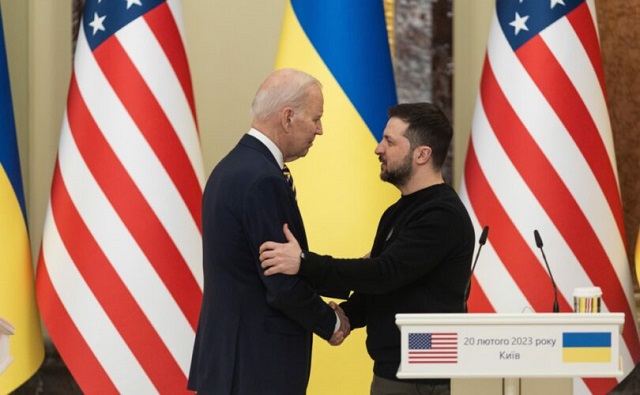conflict
Biden gives green light for Ukraine to shoot US-provided missiles into Russian territory

From LifeSiteNews
This is a major escalation of NATO engagement, likely intended to provoke Russia to strike alternate targets.
According to Politico and the New York Times the Biden administration has given Ukraine approval to launch U.S.-provided missiles into Russia. This is a major escalation of NATO engagement, likely intended to provoke Russia to strike alternate targets. The people inside Ukraine responsible for using these U.S. provided weapons are likely not Ukrainian.
CTH is in an unusually serendipitous position to analyze how Russia is responding to this shift in U.S. position. The morale inside Russia is very high amid the military-age population. The recruitment efforts of the Russian government appear to be numerous and very effective.
There are thousands of newly enlisted military personnel very visible in/around training facilities. There is no apparent tension discernable. Overall Russia appears to take great pride in their military, and it is considered a matter of honor and pride to support them.
From Politico:
The Biden administration has quietly given Ukraine permission to strike inside Russia – solely near the area of Kharkiv – using U.S.-provided weapons, two U.S. officials and two other people familiar with the move said Thursday, a major reversal that will help Ukraine to better defend its second-largest city.
‘The president recently directed his team to ensure that Ukraine is able to use U.S. weapons for counter-fire purposes in Kharkiv so Ukraine can hit back at Russian forces hitting them or preparing to hit them,’ a U.S. official said, adding that the policy of not allowing long-range strikes inside Russia ‘has not changed.’
… In effect, Ukraine can now use American-provided weapons, such as rockets and rocket launchers, to shoot down launched Russian missiles heading toward Kharkiv, at troops massing just over the Russian border near the city, or Russian bombers launching bombs toward Ukrainian territory. But the official said Ukraine cannot use those weapons to hit civilian infrastructure or launch long-range missiles, such as the Army Tactical Missile System, to hit military targets deep inside Russia.
It’s a stunning shift the administration initially said would escalate the war by more directly involving the U.S. in the fight. But worsening conditions for Ukraine on the battlefield – namely Russia’s advances and improved position in Kharkiv – led the president to change his mind.
You can tell from the general vibe amid the officials of government, Russia is not playing around with their military approach toward previous NATO encroachment or the provocations by the U.S. The sense is that Russia is in this for the long haul and their structural changes in the aftermath of the sanction regime are not temporary. Russians overall are hard and resilient to the reality of things as they are, not as they would wish them to be.
Russia appears to be entirely prepared financially, sociologically, and economically to remain disconnected from the “West.” Asia and India are filling the economic void created by Western sanctions. Amid ordinary life, the general Russian sentiment seems to be one of acceptance to the geopolitical isolation.
In recent weeks, the push toward further conflict with Russia seemed to be diminishing; however, this direct action by Biden and the State Dept. puts the U.S. (NATO) in a more aggressive posture.
Hungarian Prime Minister Viktor Orbán opposes the escalation by NATO:
During a Friday interview on state radio, Orbán said that French President Emmanuel Macron’s stance that he wouldn’t rule out sending troops to Ukraine, as well as a NATO proposal that would allow Kyiv to strike military bases inside Russia with sophisticated long-range weapons provided by Western partners, risked escalating the war in Ukraine into a global conflict.
‘War is a monster that is constantly hungry, it must be fed, and it must be fed with money. And I see that the Americans and the Democratic government of the United States, and the leaders of the European Union, are ready to feed it,’ he said.
Reprinted with permission from the Conservative Treehouse.
conflict
“Evacuate”: Netanyahu Warns Tehran as Israel Expands Strikes on Iran’s Military Command

 Sam Cooper
Sam Cooper
As President Donald J. Trump opened meetings with Western leaders at the G7 summit in Alberta early Monday, multiple reports signaled a dramatic escalation in Israel’s military campaign against Iran—a broader and potentially more lethal phase of the conflict. In a televised address, Prime Minister Benjamin Netanyahu urged citizens of Tehran to “evacuate,” confirming Israeli aircraft were operating deep inside Iranian airspace. Meanwhile, as U.S. military assets approach the Middle East by sea and air, Trump issued a stark warning to Iran’s leadership, cautioning against any retaliation targeting U.S. military assets in the region.
“We are telling the citizens of Tehran: evacuate,” Netanyahu reportedly declared from a secure facility beneath Tel Aviv. “We are taking action to eliminate the existential threat posed by Iran’s nuclear and ballistic missile program.”
Trump, speaking from Calgary hours before his closed-door G7 meetings, warned that any attack on U.S. military personnel or facilities “would be met with overwhelming force,” according to statements confirmed by Reuters.
The warnings accompanied a new wave of Israeli airstrikes early Monday targeting underground missile facilities, command bunkers, and air defense batteries across central Iran. Reuters, citing Israeli military officials, confirmed that dozens of warplanes were involved in the overnight operation, striking missile storage sites near Qom and key military complexes southwest of Tehran.
Israel also said it had struck the Tehran command center of Iran’s elite Quds Force, in what The New York Times and Reuters described as a major escalation in the deadliest confrontation between the two countries to date. Analysts note the Quds Force plays a central role in organizing the Iranian regime’s network of regional proxy militias.
Now in its fourth day, the conflict has claimed at least 224 lives in Iran and more than 20 in Israel, with thousands wounded. Israeli officials said eight people were killed in Monday’s strikes alone.
Iran’s Health Ministry reported more than 1,400 wounded, while Israeli authorities said some 600 have been injured since hostilities began.
Meanwhile, President Trump reportedly rejected an Israeli plan to assassinate Iran’s Supreme Leader Ayatollah Ali Khamenei, three U.S. officials told CBS according to BBC, in a report published Sunday. Trump reportedly told Netanyahu the plan was “not a good idea,” and the conversation is said to have taken place after Israel launched its first strike on Friday.
Unverified reports on Monday suggested that Iranian leaders may be seeking a diplomatic exit from the conflict by pledging to halt nuclear enrichment—but are also searching for a face-saving mechanism that would allow them to preserve regime legitimacy. These claims have not been confirmed by U.S. or Israeli intelligence but are circulating among regional analysts.
BBC News, citing regional correspondents and satellite imagery, reported sustained Israeli bombardments along a corridor stretching from Esfahan to the outskirts of Tehran. Footage broadcast by Iran’s semi-official Fars News Agency showed thick plumes of black smoke rising from industrial zones in Kermanshah and explosions near known missile research installations long suspected by Western governments of contributing to Iran’s nuclear infrastructure.
Iranian authorities, while acknowledging the scale of the attacks, have characterized them as “limited,” claiming that their air defense systems intercepted many incoming missiles.
According to the Wall Street Journal, U.S. early warning systems detected a flurry of retaliatory missile activity inside western Iran shortly after the Israeli strikes began. However, no launches were confirmed—fueling speculation that Iran’s top leadership is seeking to avoid a direct confrontation with the United States or Israel at this stage.
Still, the risks of an expanding war remain acute. U.S. Central Command has confirmed that naval and air assets—including carrier strike groups and long-range bombers—have been repositioned to heightened readiness levels across the Persian Gulf and Eastern Mediterranean.
The Bureau is a reader-supported publication.
To receive new posts and support my work, consider becoming a free or paid subscriber.
Invite your friends and earn rewards
conflict
One dead, over 60 injured after Iranian missiles pierce Iron Dome

 MxM News
MxM News
Quick Hit:
Iran launched four waves of missile attacks Friday night, breaching Israel’s defenses and killing at least one person. Over 60 others were injured, with the IDF confirming direct strikes on civilian areas in Tel Aviv and central Israel.
Key Details:
-
The Israel Defense Forces reported four rounds of Iranian missile fire, with at least ten missiles making impact inside Israel.
-
One person was killed and 63 wounded, including several in critical condition, according to The Jerusalem Post.
-
The IDF said Iran deliberately targeted civilians, contrasting its own earlier strikes that focused on Iranian military assets.
⚠️RAW FOOTAGE: Iran launched multiple ballistic missiles toward Israel in the past hours.
The IDF cannot, and will not, allow Iran to attack our civilians. pic.twitter.com/IrDK05uErm
— Israel Defense Forces (@IDF) June 13, 2025
Diving Deeper:
Several Iranian missiles broke through Israel’s air defenses during Friday night’s attack, striking Tel Aviv and other civilian areas. According to The Jerusalem Post, at least 63 people were wounded and one person was killed after four waves of Iranian ballistic missile strikes hit cities across Israel.
The IDF reportedly said roughly 100 missiles were fired in total. While the Iron Dome intercepted many, multiple missiles made it through and exploded in densely populated areas. Dramatic video showed a missile striking near downtown Tel Aviv, sending fire and debris into the air as people ran for cover.
Army Radio confirmed that ten missiles landed inside Israel between the first two waves. By the time the third and fourth waves hit, injuries had climbed sharply, with several listed in critical condition. The one fatality was reported late Friday night.
The Israeli Home Front Command temporarily allowed civilians to exit shelters but quickly reversed that guidance, urging residents to stay near protected areas amid fears of further attacks.
The IDF emphasized the nature of the targets, calling out Iran for targeting civilians. The IDF also released maps showing where air raid sirens were triggered throughout the night. Though Israel’s Home Front Command briefly allowed civilians to exit shelters, it advised them to remain nearby in case of continued strikes. As of late Friday, Iranian officials claimed a fifth wave could follow.
With tensions still high, Israeli defense officials are preparing for potential further escalation—and weighing how to respond to a direct Iranian attack on civilians.
-

 Business20 hours ago
Business20 hours agoCarney’s European pivot could quietly reshape Canada’s sovereignty
-

 Alberta19 hours ago
Alberta19 hours agoAlberta’s grand bargain with Canada includes a new pipeline to Prince Rupert
-

 Crime1 day ago
Crime1 day agoManhunt on for suspect in shooting deaths of Minnesota House speaker, husband
-

 Bruce Dowbiggin4 hours ago
Bruce Dowbiggin4 hours agoWOKE NBA Stars Seems Natural For CDN Advertisers. Why Won’t They Bite?
-

 Energy4 hours ago
Energy4 hours agoCould the G7 Summit in Alberta be a historic moment for Canadian energy?
-

 Crime4 hours ago
Crime4 hours agoMinnesota shooter arrested after 48-hour manhunt
-

 conflict5 hours ago
conflict5 hours ago“Evacuate”: Netanyahu Warns Tehran as Israel Expands Strikes on Iran’s Military Command
-

 Aristotle Foundation2 hours ago
Aristotle Foundation2 hours agoThe Canadian Medical Association’s inexplicable stance on pediatric gender medicine




